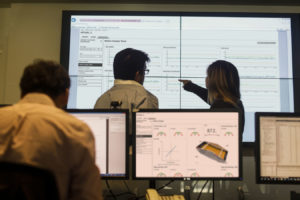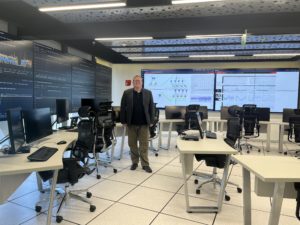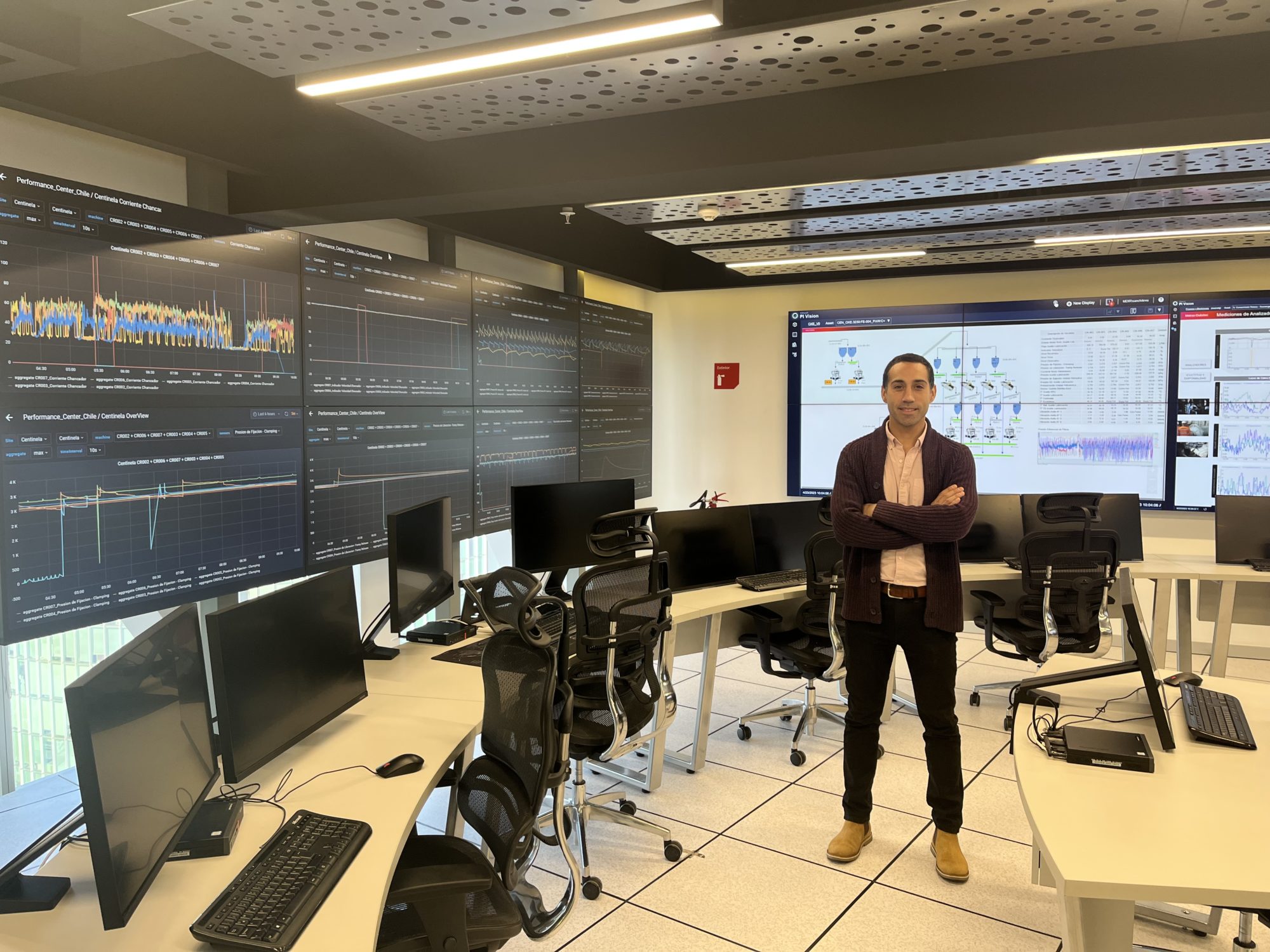In April 2023, IM Editorial Director Paul Moore toured Metso’s state of the art Performance Center in Santiago, Chile with Pablo Zuniga – Metso’s Remote Services Manager (pictured at the facility above). The facility is just a small part of Metso’s office space in the city but an increasingly important one as mining houses look to maximise efficiency using the latest available technology.
Metso started to build the Performance Center back in 2019, with all the construction completed between April and mid-year 2020. Zuniga joined in January 2020 – having spent about 12 years working with mining companies in processing plant maintenance roles – first with Codelco and then with Antofagasta Minerals. He told IM: “I am an electronic engineer – and started in mining as an instrumentation supervisor in the Codelco Andina concentrator plant. I then moved into a reliability management role at that operation – before moving to AMSA’s Antucoya where I held the role of Reliability Superintendent. So, my experience has involved working with concentrator plant equipment and specifically maintenance and reliability aspects. This involved looking at solutions related to preventive, predictive and prescriptive maintenance.”
He explained that in mining concentrator plants you can have the control systems, advanced process control (APC), model process control and overall automation systems. “But you also have individual areas of automation – plus additional tools – such as using machine learning or instrumentation to monitor asset health in order to try and predict what is going to happen based on historical data as well as the original equipment specifications, set points and limits which of course as the equipment supplier we are the most knowledgeable in. You can start to map the behaviour of a piece of equipment in this way.”
What you are trying to do is detect specific failures and for that you need also expert information that includes knowing the limits for each kind of signal. For predictive maintenance you must find a way to predict failures – to some extent you know how it is going to behave as you have experts with deep equipment experience as well as the manuals with all the information and values related to the equipment.
Prescriptive maintenance is a combination of human expertise and machine learning

He continued: “But you can then add a layer – using machine learning and cloud computing to get information from the site with different IoT tools. You get signals from the site, upload those signals to the cloud and to some kind of hard-wired infrastructure to process that raw data. At that point you do need the historical data to show examples of the behaviour of the equipment in different situations, such as a reaction to changes in ore chemistry, and build up algorithm-based models that are going to predict a failure without having to have a human expert monitoring it. But it doesn’t rely on algorithms alone – you also have to almost ‘teach’ the model for each mode of failure.”
Metso is building these models for diverse types and models of equipment at the Performance Center. Once the model is in place it has two things to offer the customer – it of course has human experts remotely monitoring data to predict and prevent problems and failures. “Then you also have the machine learning based models looking for potential failures 24/7. The expert is doing the prescriptive part – you can predict a failure but then the expert validates it and then based on their experience decides what they believe is happening and why, and then opts for the right action or response for the site to avoid that failure. This is the essence of prescriptive maintenance.”
So why did Metso need a dedicated Performance Center facility and was it driven by Metso or by the customer? “I would say initially it was Metso-driven – as we were looking to develop these kinds of remote services based on machine learning and cloud computing. We wanted to use digital intelligence to help the customer increase efficiency in a better way – use more technology to assist the client combined with our expert knowledge in our own equipment. The establishment of a Performance Center was needed as it would be hard to conduct prescriptive maintenance on the customer’s own site. They are more focused on operations and scheduled maintenance rather than detailed signal analysis.”
Also having a centrally located Performance Center in the city enables Metso to be more inclusive – it can have expert engineers based there that for whatever reason are not physically able to go to the actual sites due to factors such as age, gender, or disability. “For example, we have engineers here that are in their 70s but with unique experience. At the other end of the scale young people are much more likely to stay with Metso long term if they are not having to live on remote mining sites.”
Santiago’s Performance Center is complemented by Metso Performance Centers in Espoo, Finland and Changsha, China. In Santiago, there are currently 11 engineers supporting the Chile Center – some of them are not based in the Performance Center but provide remote infrastructure and software development or programming support. The human expert part of the monitoring is during normal Chilean day shift hours, not 24/7, but the technical platform and tools are operating all the time. The experts are divided by technology, not by mine – so currently there are crusher and screen experts, plus a mill expert for both horizontal and vertical mills, as well as an analyser expert monitoring Metso Courier and PSI on-stream analysers. The Center has also begun monitoring Metso pumps and grinding mills at customer mines.
IM asked Zuniga for examples of failures or failure predictions that have been identified for mining clients. “A common one is related to dust and fines in the crushing area which can start to cause oil contamination in the crusher if the hydraulic system is not very well sealed. This contamination can eventually damage the equipment. Using the pressure of the hydraulic system, and the differential pressure at the filter, we can detect when this type of contamination is increasing before it gets to a critical stage. The customer can then change the filter to avoid equipment stoppages later. A failure is always more costly than a planned shutdown.” From the Performance Center, Metso is monitoring large cone crushers including the MP800, MP1000, MP1250 and MP2500.
Metso monitors large cone crushers from its Performance Center in Santiago including the MP2500

For Courier analysers, the Performance Center is doing online calibration. “When you are operating a flotation plant you need to know what the percentage of copper is in the cell feed and the overflow froth. This information allows the operator to adjust parameters such as the reagent delivery. So, the accuracy of the Courier is crucial – and our monitoring helps ensure the precision of those analysers.” The site takes regular samples and use certified measurements of copper content in the feed and froth and the tails – Metso compares that with the Courier data and if there is any difference, even 1 or 2% then the Courier is recalibrated. This recalibration is done normally once or sometimes twice a week. One Courier can have up to six flows and a major mine can have multiple Couriers.
The Performance Center is currently only monitoring Metso equipment – and beyond the recognised quality of the Metso equipment in the first place, having this prescriptive maintenance service helps to act as an added differentiator for customers. It is offered to customers as a value-added service – but also for some new equipment it is part of a warranty package for one year. It can also be added as part of an upgrade, or form part of a fixed maintenance or Life Cycle Services contract with a site. It is entirely retrofittable to existing equipment.
So, what has been added since inception and how will these services grow and evolve going forward in both Santiago and elsewhere? “We started only in 2020 with an MP1250 cone crusher. Now we have all the Metso MP crushers able to be supported from the Centers. We then added HP crushers and will soon offer these services for MKII and MKIII Superior primary gyratory crushers as well. We have the PSI and Courier analysers, as well as screens and pumps. Later in 2023 we are adding more grinding mills – we already have two connected and are adding two more. This includes both SAG and ball mills, and both gearless and gear driven. In addition to these technologies, in Espoo, Finland, they are monitoring pressure and belt filters.”
IM Editorial Director, Paul Moore, at the Metso Performance Center in Chile

The Performance Center in Santiago is not just monitoring equipment located in Chile. It is also monitoring crushing equipment in Panama, as well as supporting the monitoring of equipment for the Performance Center in Finland looking at signals for crushers and other equipment in Europe, South Africa and Finland. Likewise, if the Chile Performance Center were to connect a filter press – then Finland could perform a similar function. “We work together to transfer knowledge and to share experience and best practices. All the infrastructure that we have is cloud based and you can see the information from anywhere.”
How does the Performance Center interact with the customer? They have user interface visualisations: “We have two comms channels – the customers receive email alerts that inform them on what we are seeing and what the potential failure could be and what could be the impact of that failure, plus the actions they need to take to avoid that failure. We also have regular scheduled meeting with customers where we summarise which actions they have impending. We also have some kind of contact with every customer on a daily basis.”
Usually, the main Metso contact at the customer site for these meetings is a senior engineer, who reports to the superintendent of the plant and ultimately to the plant manager; but the superintendent is also part of any maintenance and operations communications especially for any serious or critical issues that arise during remote monitoring.
How fast is demand for these remote services growing? “At the beginning because it was new, customers were quite conservative, as is typical in mining. Or they wanted proof of the value before committing to it. So, we started offering it as a free add on as part of other services. Our first customer, a major Chilean copper mine, used the remote monitoring for seven months as part of a pilot then immediately recognised the value of the service and committed to continue on a paid for basis. Now we have more equipment supported with our customers, spanning a range of different technologies. And we are now in the process of starting monitoring for them at their other concentrator plant.” Zuniga emphasised the important of liaising with the right person at the site – ideally someone in the maintenance team – to be able to demonstrate the value.
Looking to the future and the metaverse
The scope of the Performance Centers is continuing to widen under its provision of Expert Services. “Today at the Performance Center we are not only doing remote monitoring. Today in mining you have Industry 4.0 and all the technologies you could be applying – these also have a sustainability benefit as well – what we in Metso call Planet Positive. We started with IoT, Big Data, Cloud Computing and Machine Learning for our predictive and prescriptive maintenance. We also have an Automation offering, which includes Advanced Process Control (APC), Advanced Instrumentation, Digital Twins and Model Process Control (MPC). Now we are adding augmented reality and virtual reality in various kinds of applications.”
These have two different uses – AR is when you can mix reality with some kind of digital element, like a hologram. Metso uses that to assist the customer in the field. So instead of having an expert travelling to the site which might take two days, they can use AR from here in Santiago. “The engineer or supervisor at the customer site puts on special AR HoloLens glasses and we can then see what they are seeing and deploy distinct types of help using the glasses. We are also creating a metaverse, using VR to have digital versions of our equipment within a virtual platform to be able to teach people using avatars in an interactive way about the different parts and dimensions – they learn much faster this way than from a presentation or a written manual. We are already doing this for training customers today. We also use it at mining tradeshows.”
Zuniga hired a specialist IT company in Chile called Minverso to create a Metso metaverse, based on Metso’s equipment and experience. “It also allows global based training – you could have a trainer in Chile and the trainee in South Africa as an example as it just needs an internet connection with voice chat. We have developed this metaverse capability in Chile, but we are now working with the Metso Training Academy in Finland to expand the platform and make it available to Metso teams in different countries to offer to customers.”











